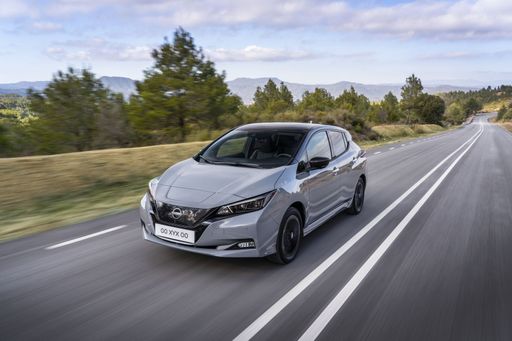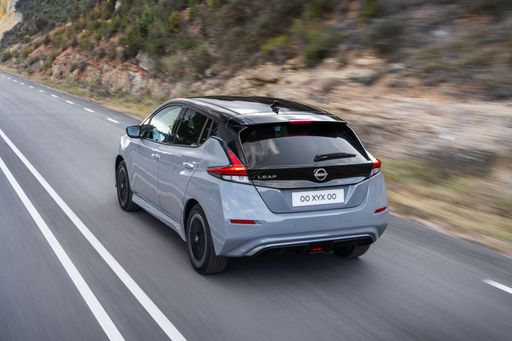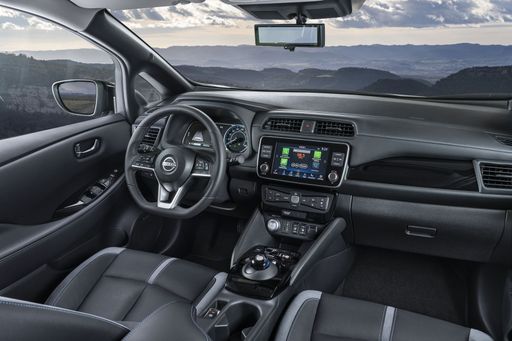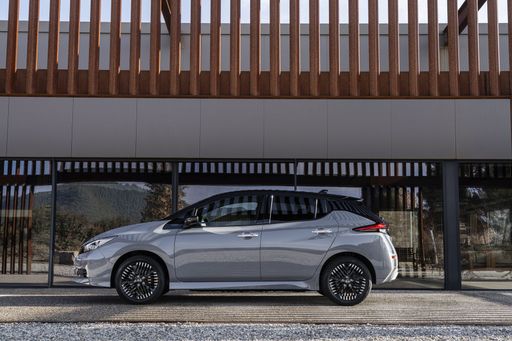Nissan Leaf VS Citroen Ami – Specs, Efficiency & Price Comparison
Which model is the better choice – the Nissan Leaf or the Citroen Ami? We compare performance (217 HP vs 8 HP), boot capacity (394 L vs 63 L), efficiency (16.70 kWh vs ), and of course, the price (30800 £ vs 6800 £).
Find out now which car fits your needs better!
The Nissan Leaf (Hatchback) is powered by a Electric engine and comes with a Automatic transmission. In comparison, the Citroen Ami (Hatchback) features a Electric engine and a Automatic gearbox.
When it comes to boot capacity, the Nissan Leaf offers 394 L, while the Citroen Ami provides 63 L – depending on what matters most to you. If you’re looking for more power, you’ll need to decide whether the 217 HP of the Nissan Leaf or the 8 HP of the Citroen Ami suits your needs better.
There are also differences in efficiency: 16.70 kWh vs . In terms of price, the Nissan Leaf starts at 30800 £, while the Citroen Ami is available from 6800 £.
Compare all the key specs now and find out which model fits your lifestyle best!
Nissan Leaf
The Nissan Leaf stands out as a pioneering model in the realm of electric vehicles, known for its impressive blend of practicality and eco-friendliness. It offers a smooth and quiet driving experience, making it an ideal choice for city commuting and longer journeys alike. The interior design is both comfortable and intuitive, providing drivers with a sense of modernity and ease of use.
details @ germany.nissannews.com
@ germany.nissannews.com
 @ germany.nissannews.com
@ germany.nissannews.com
 @ germany.nissannews.com
@ germany.nissannews.com
 @ germany.nissannews.com
@ germany.nissannews.com
Citroen Ami
The Citroen Ami is a distinctive electric microcar that has captured the attention of urban commuters with its compact design and eco-friendly credentials. Its unique boxy shape and minimalist interior appeal to those seeking a practical and sustainable solution for city driving. As an affordable and innovative mobility option, the Ami is perfect for navigating tight spaces and making short trips with ease.
details

|
|
|
|
|
Costs and Consumption |
|
|---|---|
|
Price
30800 - 37200 £
|
Price
6800 - 7700 £
|
|
Consumption L/100km
-
|
Consumption L/100km
-
|
|
Consumption kWh/100km
16.7 - 17.8 kWh
|
Consumption kWh/100km
-
|
|
Electric Range
270 - 385 km
|
Electric Range
75 km
|
|
Battery Capacity
39 - 59 kWh
|
Battery Capacity
5.40 kWh
|
|
co2
0 g/km
|
co2
0 g/km
|
|
Fuel tank capacity
-
|
Fuel tank capacity
-
|
Dimensions and Body |
|
|---|---|
|
Body Type
Hatchback
|
Body Type
Hatchback
|
|
Seats
5
|
Seats
2
|
|
Doors
5
|
Doors
2
|
|
Curb weight
1580 - 1756 kg
|
Curb weight
558 kg
|
|
Trunk capacity
385 - 394 L
|
Trunk capacity
63 L
|
|
Length
4490 mm
|
Length
2410 mm
|
|
Width
1788 mm
|
Width
1388 mm
|
|
Height
1540 - 1545 mm
|
Height
1525 mm
|
|
Payload
384 - 415 kg
|
Payload
142 kg
|
Engine and Performance |
|
|---|---|
|
Engine Type
Electric
|
Engine Type
Electric
|
|
Transmission
Automatic
|
Transmission
Automatic
|
|
Transmission Detail
Reduction Gearbox
|
Transmission Detail
-
|
|
Drive Type
Front-Wheel Drive
|
Drive Type
Front-Wheel Drive
|
|
Power HP
150 - 217 HP
|
Power HP
8 HP
|
|
Acceleration 0-100km/h
6.9 - 7.9 s
|
Acceleration 0-100km/h
-
|
|
Max Speed
144 - 157 km/h
|
Max Speed
45 km/h
|
|
Torque
320 - 340 Nm
|
Torque
44 Nm
|
|
Number of Cylinders
-
|
Number of Cylinders
-
|
|
Power kW
110 - 160 kW
|
Power kW
6 kW
|
|
Engine capacity
-
|
Engine capacity
-
|
General |
|
|---|---|
|
Model Year
2019
|
Model Year
2024
|
|
CO2 Efficiency Class
A
|
CO2 Efficiency Class
A
|
|
Brand
Nissan
|
Brand
Citroen
|
Nissan Leaf
Introduction to the Nissan Leaf: A Pioneer in Electric Mobility
The Nissan Leaf has established itself as a trailblazer in the realm of electric vehicles (EVs) since its launch. As we delve into its present-day iterations, the Leaf continues to soar in popularity due to remarkable advancements in technology and sustainability. Let's explore what makes the Nissan Leaf a standout in today's automotive market.
Power and Performance: Under the Hood of the Nissan Leaf
The Nissan Leaf boasts a power output ranging from 150 to 217 PS, depending on the battery option chosen. The vehicle's electric motor, a product of cutting-edge engineering, offers instant torque ranging from 320 to 340 Nm, resulting in impressive acceleration capabilities. The 0 to 100 km/h dash is achieved in as little as 6.9 seconds, showcasing its prowess in electric performance.
Battery Technology: Efficient Energy Management
When discussing the Nissan Leaf, battery technology is at the forefront. The available battery capacities range from 39 to 59 kWh, supporting an electric range between 270 to 385 km. This flexibility allows drivers to choose a model that best fits their driving habits, providing peace of mind for longer journeys without frequent recharging.
Sustainability: The Environmental Edge
One of the primary attractions of the Nissan Leaf is its commitment to sustainability. As an all-electric vehicle, it produces zero CO2 emissions, placing it in the top tier of the CO2-efficiency class with an 'A' rating. This clean energy approach contributes significantly to reducing environmental impact and supports Nissan's drive towards a greener future.
Design and Comfort: Aesthetic Appeal and Practicality
The Nissan Leaf is not just about efficiency; it's also designed for comfort and utility. With its sleek hatchback body and dimensions of 4490 mm in length, 1788 mm in width, and a height of up to 1545 mm, it offers ample interior space. The boot capacity ranges from 385 to 394 litres, providing sufficient storage for everyday needs. The model accommodates five passengers comfortably, ensuring a pleasant ride for everyone.
Innovations and Safety: Advanced Features for Peace of Mind
Nissan equips the Leaf with an array of intelligent features that enhance safety and convenience. The available equipment lines, including N-CONNECTA, Tekna, e+ N-CONNECTA, and e+ Tekna, offer varying levels of technology integration. ProPILOT Assist, e-Pedal, and a comprehensive suite of driver-assistance technology are just a few examples that highlight Nissan's commitment to innovation in the EV market.
Conclusion: The Nissan Leaf Continues to Lead
With prices ranging from €35,900 to €43,400, the Nissan Leaf remains an attractive choice for those looking to embrace electric mobility. It perfectly balances performance, design, and sustainability, making it a compelling choice in the competitive EV landscape. The Nissan Leaf not only represents the future of driving but also reinforces why it continues to be a leader in the electric vehicle community.
Citroen Ami
The Revolutionary Design of the Citroen Ami
The Citroen Ami represents a paradigm shift in urban mobility with its unique design and innovative features. As a compact city vehicle, the Ami embraces a minimalist aesthetic with its quirky and symmetrical design. Measuring just 2,410 mm in length, the Ami is tailored for navigating tight city streets with ease while its efficient use of space offers practicality for daily commutes.
Technical Specifications: A Powertrain Built for the City
The Citroen Ami is powered by an electric motor that delivers 8 PS and approximately 6 kW. This motor, paired with a front-wheel-drive system and an automatic transmission fitted with a simple but effective reduction gearbox, offers straightforward operation ideal for city driving. The Ami boasts a torque of 44 Nm, ensuring zippy performance at lower speeds.
Electric Efficiency and CO2 Neutrality
One of the standout features of the Citroen Ami is its CO2 efficiency. As an electric vehicle, it emits no CO2, aligning itself with modern environmental standards. The vehicle's efficiency is further highlighted by its energy consumption, with a battery capacity of 5.4 kWh that grants the Ami a range of up to 75 km on a single charge. These capabilities position it as a frontrunner in CO2-Effizienzklasse A.
Compact Dimensions and Practicality
Built for the urban environment, the Ami's compact dimensions—2,410 mm in length, 1,388 mm in width, and 1,525 mm in height—make it exceptionally manoeuvrable. With a maximum speed of 45 km/h, it is designed for efficiency rather than speed. Despite its size, the Ami provides a surprisingly spacious interior with seating for two and a 63-litre storage capacity, cleverly making the most of its architectural space.
Cost-Effective Urban Transport
The Citroen Ami stands out not only for its design but also for its affordability. With a price range between €7,990 and €8,990, it offers a cost-effective solution for individuals seeking efficient city transport without compromising on style or eco-friendliness.
Model Year and Trim Options
The 2024 Citroen Ami is offered in attractive trim options such as Colour and Peps, providing customisation choices to suit a variety of tastes. These options add a personal touch to its already appealing minimalist design.
In conclusion, the Citroen Ami offers a fresh perspective on urban commuting with its innovative design and sustainable features. It's perfectly positioned to make a substantial impact on eco-friendly urban transport.
The prices and data displayed are estimates based on German list prices and may vary by country. This information is not legally binding.
